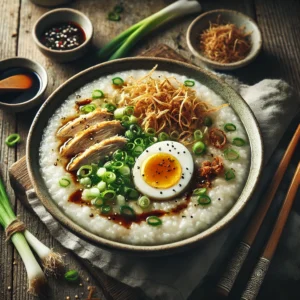Few dishes can claim the universal appeal of congee, the humble rice porridge that transcends borders and cultures. A staple in many Asian cuisines, congee’s simplicity belies its profound versatility, health benefits, and adaptability. Let’s dive into what makes this dish so special and how it has found a place on tables worldwide.
What is Congee?
Congee, also known as jook, khao tom, bubur, or arroz caldo depending on the region, is a rice-based porridge traditionally made by simmering rice in water or broth until it reaches a creamy, soup-like consistency. Its texture can vary from silky smooth to hearty and chunky, depending on cultural preferences and cooking techniques.
Often enjoyed as a breakfast dish or a comforting meal during illness, congee is both food and medicine in many traditions. It serves as a blank canvas for a variety of toppings and flavors, from savory to sweet.
Health Benefits of Congee
Congee’s health benefits have made it a cornerstone of traditional diets, particularly in East and Southeast Asia. Here’s why it stands out:
- Gentle on Digestion
- The soft, easily digestible nature of congee makes it ideal for those with sensitive stomachs, recovering from illness, or seeking a light yet nourishing meal.
- It’s often prescribed in Traditional Chinese Medicine (TCM) as a healing food, believed to strengthen the digestive system and restore balance.
- Hydrating and Nourishing
- Congee has a high water content, which helps with hydration, especially in hot climates or during recovery.
- When cooked with nutrient-rich broths or combined with vegetables and proteins, it becomes a wholesome meal packed with essential vitamins and minerals.
- Customizable for Dietary Needs
- Congee can be adapted for various diets. It can be made gluten-free, dairy-free, or vegetarian, and toppings can range from high-protein options like eggs and chicken to plant-based additions like tofu and mushrooms.
- Low in Calories
- A bowl of plain congee is low in calories, making it a great option for those managing their weight or seeking a light meal.
Congee Around the World
Although its origins are rooted in Asia, congee has evolved and taken on unique forms in different parts of the world:
- China
- Known as jook (粥), Chinese congee is often seasoned with soy sauce, ginger, and scallions. It’s commonly served with pickled vegetables, century eggs, or shredded chicken.
- Japan
- Called okayu (おかゆ), Japanese congee is usually milder in flavor, often garnished with umeboshi (pickled plums) or nori. It’s a staple comfort food during cold seasons or for those feeling under the weather.
- India
- In South India, a similar dish called kanji is popular, often flavored with coconut, spices, and lentils. In Kerala, rice kanji is paired with side dishes like pickles and lentil curries.
- Southeast Asia
- Thailand: Known as khao tom, Thai congee includes garlic, fish sauce, and fresh herbs. Often served with meatballs or seafood.
- Vietnam: Cháo is often enriched with ginger, fish sauce, and proteins like pork or duck.
- Indonesia: Bubur ayam is a savory congee topped with shredded chicken, crispy shallots, and sambal.
- Philippines
- Arroz caldo, influenced by Spanish cuisine, is a ginger-flavored congee often garnished with fried garlic, hard-boiled eggs, and calamansi.
- Western Adaptations
- In the West, congee is gaining popularity as a healthy, gluten-free breakfast alternative. Creative toppings like avocado, roasted vegetables, and poached eggs are bringing modern twists to this ancient dish.
The Universal Appeal of Congee
Congee’s appeal lies in its adaptability. It’s a dish that can be as simple or as elaborate as you desire, tailored to suit your tastes, dietary restrictions, and cultural influences. Whether it’s a bowl of plain congee enjoyed for its soothing qualities or a vibrant creation bursting with flavors and textures, congee is a dish that invites creativity and connection.
In a world that’s increasingly drawn to wholesome and comforting foods, congee stands out as a timeless classic, uniting people through its universal warmth and nourishment.

Congee
Ingredients
For the Congee
- ½ cup Jasmine Rice
- 5 Cups Water or Chicken Stock
- 1 inch Ginger thumb-sized, sliced
- ½ tsp salt
Toppings
- 1 cup Shredded Chicken cooked (or tofu for a vegetarian option)
- 1 Boiled Egg halved
- 2 tbsp Soy Sauce
- 2 tbsp Shallots Crispy fried
- 2 tbsp Scallions chopped
- Optional: sesame oil, chili oil, or white pepper for garnish
Instructions
Prepare the Congee
- Rinse the rice under cold water until the water runs clear.
- In a medium pot, combine the rice, water (or chicken stock), ginger, and salt.
- Bring to a boil, then reduce the heat to low. Simmer for 45–60 minutes, stirring occasionally, until the rice breaks down and the mixture reaches a porridge-like consistency. Add more water if needed.
Prepare the Toppings
- Shred the cooked chicken and set aside.
- Boil an egg to your desired doneness (6–7 minutes for a soft-boiled egg).
Assemble and Serve
- Divide the congee into two bowls.
- Top each bowl with shredded chicken, half an egg, fried shallots, scallions, and a drizzle of soy sauce.
- Optional: Add sesame oil, chili oil, or white pepper to taste.

